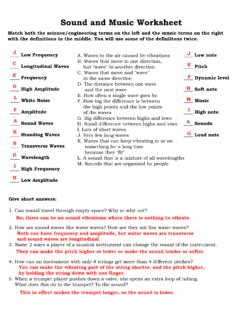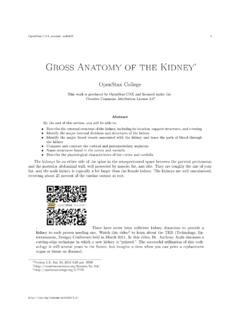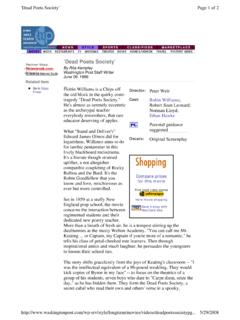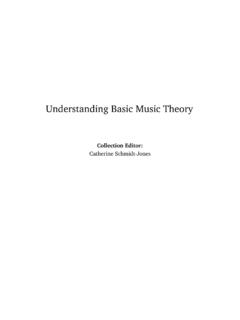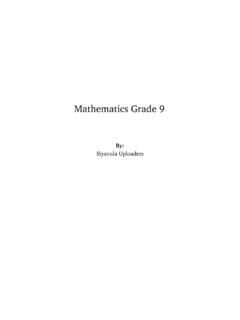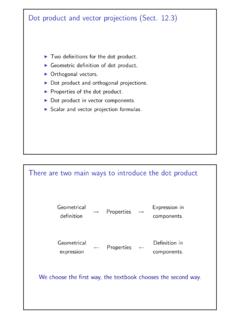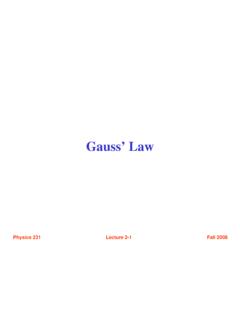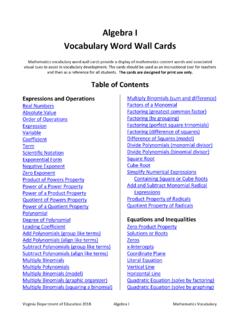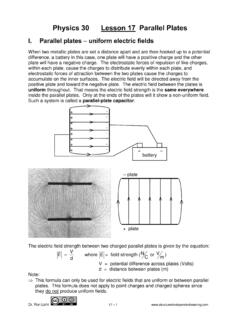Transcription of Section 16: Neutral Axis and Parallel Axis Theorem
1 Section 16: Neutral Axis and Parallel Axis Theorem16-1 Geometry of deformationGeometry of deformation We will consider the deformation of an ideal, isotropic prismaticbeam the cross Section is symmetric about y-axis All parts of the beam that were originally aligned with the longitudinal axis bend into circular arcs plane sections of the beam remain plane and perpendicular to the beam s curved axisbeam s curved axisNote: we will take these directions for M0to be positive However they arepositive. However, they are in the opposite direction to our convention (Beam 7), and we must remember to account for this at the : HornseyNeutral axis16-3 From: BENDING DEFORMATION OF A STRAIGHT MEMBERA STRAIGHT MEMBER A Neutral surfaceis where longitudinal fibers of the material will not undergo a change in : BENDING DEFORMATION OF A STRAIGHT MEMBERA STRAIGHT MEMBER Thus, we make the following axisx(within Neutral surface) axis x(within Neutral surface) does not experience any change in length2.
2 All cross sectionsof the beam remain planepand perpendicular to longitudinal axis during the deformation3. Any deformationof the cross-sectionwithin its own plane will be neglected In particular, the zaxis, in plane of x- Section and about which the x- Section rotates, is called thetl i16-5 From: Wangneutral axis6 4 THE FLEXURE THE FLEXURE FORMULA By mathematical expression, equilibrium equations of moment and forces, we get AydA=0 Equation 6-10 Ay dA 0 Equation 610 Equation 6-11 maxcM = Ay2dA The integral represents the moment of inertiaof x-sectional area, computed about the Neutral axis. We symbolize its value asI16-6 From: WangWe symbolize its value as 4 THE FLEXURE THE FLEXURE FORMULA Normal stress at intermediate distance ycan be determined fromEquation 6-13 MyI = is -ve as it acts in the -ve direction (compression)Eti 612d 613ftfd t Equations 6-12 and 6-13 are often referred to as the flexure.
3 Wang*6 6 COMPOSITE COMPOSITE BEAMS Beams constructed of two or more different materials are called composite beams Engineers design beams in this manner to develop a more efficient means for carrying applied loads Flexure formula cannot be applied directly to determine normal stress in a composite beam Thus a method will be developed to transform a beam s x- Section into one made of a single material, thl th flflthen we can apply the flexure formula16-8 From: Wang16-9 From: HornseyMoments of InertiaMoments of Inertia Resistance to bending,Resistance to bending, twisting, compression or tension of an object is a function of its shape Relationship of applied force to distribution of mass (shape) with respect to an axisrespect to an : LeFigure from: Browner et al, Skeletal Trauma 2nd Ed, Saunders, ShapeImplant Shape Moment of Inertia:Moment of Inertia: further away material is spread in an object, greater the stiffness Stiffness and strength are proportional to radius416-11 From: Justice16-12 From.
4 HornseyMoment of Inertia of an Area by IntegrationSdfiif Second momentsor moments of inertiaof an area with respect to the xand yaxes, ==dAxIdAyIyx22 yx Evaluation of the integrals is simplified by choosing d to be a thin strip Parallel to one of the coordinate of the coordinate axes. For a rectangular area,322h331022bhbdyydAyIx=== The formula for rectangular areas may also be applied to strips Parallel to the axes,dxyxdAxdIdxydIyx22331===16-13 From: RabieiHomework Problem the moment ofDetermine the moment of inertia of a triangle with respect to its : RabieiHomework Problem ) Determine the centroidal polar moment of inertia of a circular area by direct integrationarea by direct ) Using the result of part a, determine the moment of inertia of a circular area with respect to a16-15 From.
5 Rabieiof a circular area with respect to a Axis Theorem Consider moment of inertia Iof an areaAwith respect to the axis AA =dAyI2 The axis BB passes through the area centroid and is called a centroidal () + + =+ ==dAddAyddAydAdydAyI222222 AdII+= Parallel axis theorem16-16 From: RabieiParallel Axis Theorem Moment of inertia ITof a circular area with respect to a tangent to the circle,()22412()445224412rrrrAdIIT =+=+= Moment of inertia of a triangle with respect to a id licentroidal axis,()2113122 AdIIBBAA+= ()33612312131212bhhbhbhAdIIAABB= = = 16-17 From: RabieiMoments of Inertia of Composite Areas The moment of inertia of a composite area Aabout a given axis is obtained by adding the moments of inertia of the component areas A1, A2, A3.
6 , with respect to the same : RabieiyExample:200(Dimensions in mm)zCtidl10zoCentroidal Axis120125n =AdA' ()()[12510200 ()()]6020120 +()2012010200y + =()[]000,144000,2501y+=000,394= ()()[12510200 ()()]6020120+16-19 From: University of Auckland()[]000,144000,250400,4y+400, =Example:(Dimensions in mm)y20010 What is I? is Iz? What is maximum x? += ,z=()() =bd3()()430203203bdI32,z=()() =23yAbdI+()()()()23435102001020046102831 6-20 University of Auckland3,zyA12I+=()()()() += =Example:(Dimensions in mm)y20010 What is I? is Iz? What is maximum x? += ,z2,z1,zzIIII++=46mm10268I = 46m10268 =16-21 University of = =Maximum 'yMxz'yIzxzx = xzMMaxzxzMax,xyI = ()() = (N/m2orPa)16-22 University of Auckland()()6 Max, ()Homework Problem : Determine location of the centroid of ittiitht tcomposite Section with respect to a coordinate system with origin at the centroid of the beam strength of a W14x38 rolled steel Apply the Parallel axis Theorem to determine moments of inertia of beam Section and plate with respect to The strength of a W14x38 rolled steel beam is increased by attaching a plate to its upper flange.
7 Dti tht fi tidcomposite Section centroidal the moment of inertia and radius of gyration with respect to an axis which is Parallel to the plate and passes through the centroid of the16-23 From: Rabieipasses through the centroid of the Problem 16 4 Homework Problem : Compute the moments of inertia of theCompute the moments of inertia of the bounding rectangle and half-circle with respect to the x fi ti fth hddi The moment of inertia of the shaded area is obtained by subtracting the moment of inertia of the half-circle from the moment of inertia of the rectangleDetermine the moment of inertia of the shaded area with respect to the inertia of the : Rabiei
